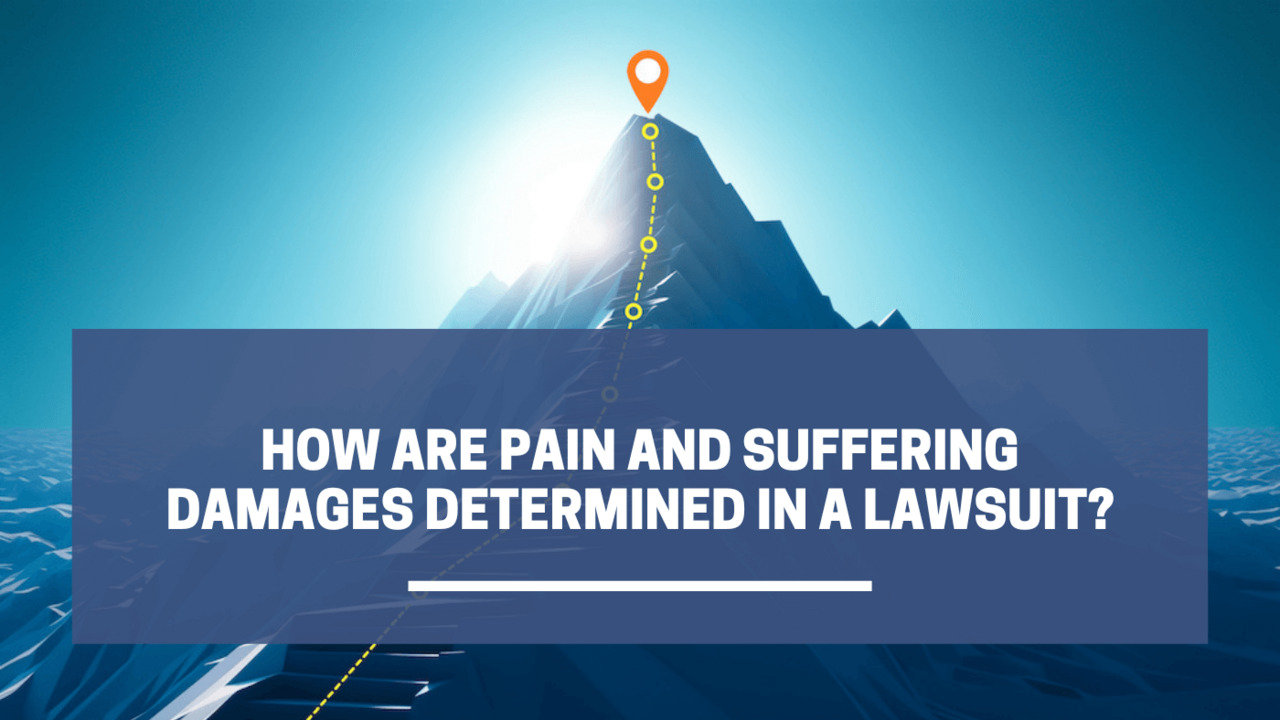Pain and suffering refers to the physical and emotional distress experienced by a victim as a result of an injury or accident caused by someone else’s negligence or intentional wrongdoing.
Determining the exact amount for pain and suffering damages can be complex because they can’t be measured like medical expenses or lost wages. The calculation of these damages involves evaluating various factors, including the severity of the injury, the impact on the victim’s quality of life, and the duration and prognosis of the pain and suffering endured.
What Types of Pain and Suffering Damages Can a Victim Seek Compensation For?
Pain and suffering damages refer to different elements of emotional distress and psychological damages a victim suffers after a personal injury accident.
- Pain-Related Damages
Pain refers to the physical discomfort, agony, and distress experienced by a victim as a direct result of the injury or incident. It includes the immediate pain felt at the time of the incident, and ongoing or chronic discomfort that persists during the recovery period. This can involve physical pain caused by injuries, surgical procedures, or medical treatments.
- Suffering Damages
Suffering refers to the emotional distress a victim endures after a personal injury accident. It includes feelings or psychological consequences such as:
-
- Mental anguish
- Emotional trauma
- Anxiety
- Depression
- Fear
- Loss of enjoyment of life
Suffering can extend beyond the immediate aftermath of the injury, potentially impacting the victim’s quality of life and overall well-being.
Examples of Pain and Suffering Settlements
Pain and suffering settlement examples can arise from a range of legal cases, including car, slip and fall, and workplace accidents, and wrongful death claims. Examples of personal injury accidents for which a pain and suffering lawyer may seek non-economic damages include:
- Workplace Accident
A construction worker suffers a severe back injury due to a fall from scaffolding that was improperly maintained by the employer. As a result, the worker experiences excruciating pain, undergoes multiple surgeries, and is left with permanent disability and chronic pain.
Pain and suffering damages for a workplace accident victim may include compensation for the physical pain endured by the worker, the emotional distress caused by the loss of mobility and inability to engage in previous activities, and the long-term impact on the worker’s quality of life.
- Workplace Death
A family loses a loved one due to a car accident caused by a negligent driver. The deceased was the primary caregiver for their children, and their sudden death creates profound emotional suffering and mental anguish for the surviving family members.
In a wrongful death claim, pain and suffering damages could be awarded to the family members to address the grief, loss of companionship, and emotional trauma they experience as a result of losing their loved one.
The settlement might consider the age and relationship of the deceased with the family members, the financial and emotional dependence on the deceased, and the long-term psychological impact caused by the loss.
What is the Average Pain and Suffering Settlement in a Car Accident?
There is no average pain and suffering settlement for personal injury cases, such as car accidents. The amount of a pain and suffering settlement are based on multiple elements, including the following:
- Severity of the injury: More severe injuries, such as spinal cord damage, traumatic brain injury, or permanent disfigurement warrant higher compensation due to the increased physical pain and long-term impact on the victim’s life.
- Duration and permanence: Longer periods of ongoing pain and suffering, and injuries that result in chronic conditions, may lead to higher compensation due to the enduring physical and emotional toll on the victim.
- Impact on daily life: A higher settlement may be awarded based on the injuries’ impact on the victim’s diminished quality of life due to limited mobility or ability to engage in hobbies. The need for ongoing medical treatment can contribute to a higher settlement to compensate for the disruption caused by the injury.
- Emotional distress: Anxiety, depression, post-traumatic stress disorder (PTSD), and other psychological impacts can be factored into the settlement to address the emotional suffering endured by the plaintiff.
- Medical treatment: Ongoing medical expenses, the need for surgeries, therapy, or medication, and the potential for future medical needs may be considered when determining pain and suffering damages.
How is Pain and Suffering Calculated?
Pain and suffering damages are calculated using two primary methods: the multiplier method and the per diem method. These approaches assign a monetary value to the intangible losses suffered by the victim.
- Multiplier Method
The multiplier method involves multiplying the victim’s economic damages (such as medical expenses and lost wages) by a specific factor known as the multiplier. This is typically a number between 1.5 and 5. The multiplier reflects the severity of the injuries, the impact on the victim’s life, and the duration and permanence of the pain and suffering.For example, if a plaintiff incurs $50,000 in medical expenses and lost wages and the multiplier is set at 3, the pain and suffering damages would be $150,000 (3 multiplied by $50,000), in addition to the economic damages. - Per Diem Method
The per diem method assigns a fixed daily rate to the pain and suffering endured by the plaintiff. The rate is often determined based on the jury’s or the judge’s assessment of the severity and impact of the injuries.To calculate the total pain and suffering damages, the per diem rate is multiplied by the number of days the victim is expected to experience pain and suffering, taking into account the anticipated recovery period or the estimated duration of the symptoms. The total can be adjusted based on the specific circumstances of the case.For instance, if the assigned per diem rate is $200 and the victim is expected to experience pain and suffering for 500 days, the pain and suffering damages would amount to $100,000 ($200 multiplied by 500).
How Do Attorneys Prove Pain and Suffering?
Attorneys use various strategies to prove pain and suffering. These methods can include using medical records and expert testimony, the victim’s personal testimony, and psychological evaluations:
- Medical records and expert testimony: These records provide objective evidence of the injuries sustained, the medical interventions, and the resulting pain and suffering the victim experiences. An attorney may hire medical experts to testify and provide professional opinions on the extent and impact of the pain and suffering.
- Witness testimony: Witnesses, such as family members, friends, or colleagues, can provide firsthand accounts of the victim’s pain and suffering. Their testimonies can describe the physical and emotional changes observed, the impact on their daily life and activities, and visible signs of distress or discomfort.
- Plaintiff’s personal testimony: An attorney will work closely with the victim to help demonstrate the physical and emotional challenges they have faced since the accident. This can include the limitations imposed on their life, the effect on the victim’s mental well-being, and the toll the injury has taken.
- Psychological evaluations: These evaluations provide professional assessments of the victim’s mental state. They can offer a diagnosis for psychological conditions, such as PTSD or anxiety disorder, and establish a link between the injury and the resulting emotional suffering.
- Demonstrative evidence: An attorney may use visual aids, such as photographs, videos, or medical illustrations, to present a clear depiction of the victim’s injuries, medical procedures, and resulting pain and suffering. These visual representations can enhance the jury’s understanding of the victim’s experience.
Does California Limit Compensation for Pain and Suffering?
California imposes limitations on compensation for pain and suffering in certain types of cases. These limitations are primarily governed by the Medical Injury Compensation Reform Act (MICRA) for medical malpractice injuries.
Under MICRA, non-economic damages, which include pain and suffering, are subject to a statutory cap. As of 2023, updates to MICRA increased the cap for non-economic damages in medical malpractice cases to $350,000 for non-fatal injury and $500,000 for a case resulting in a patient’s death.
However, the cap does not apply to personal injury cases, such as car accidents or slip and falls. In these cases, California does not place a limit on the amount of pain and suffering a victim can receive.
Getting the Compensation You Deserve After an Accident
After a personal injury incident, you may suffer physical and emotional injuries. Seeking a settlement for pain and suffering lets you receive compensation for incalculable costs related to your accident to help you rebuild your life.
While you may see a pain and suffering calculator online, the only way to accurately understand your potential damage award is by working with an attorney. A lawyer for pain and suffering who understands pain and suffering law in California can help you estimate your total damages to win what you deserve. They can include the full scope of your pain and suffering in your personal injury claim and hold the liable party responsible for all damages caused by their negligence.











